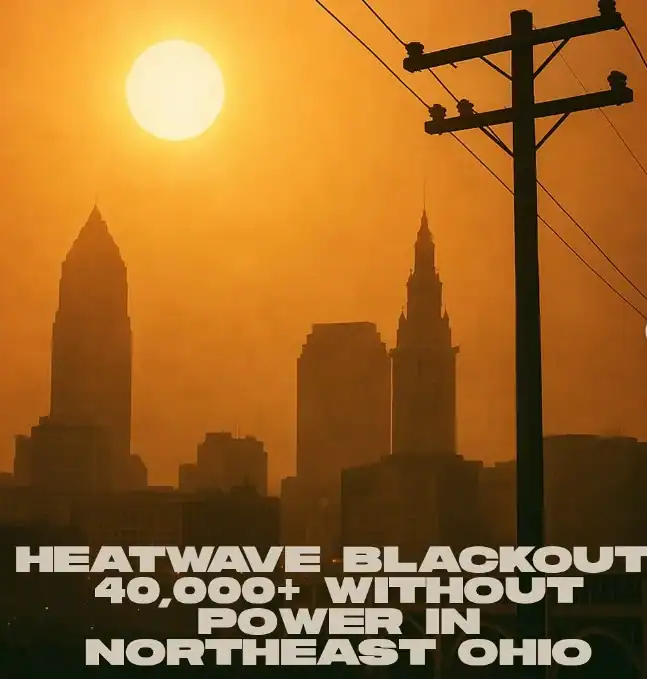|
|
By Jason Streeter Intern
Cleveland residents continue to live with the long-term consequences of decades of industrial growth and poor urban planning. From overflowing trash to worsening air quality, environmental burdens remain especially severe in East Cleveland and nearby East Side neighborhoods. Yet, amid these challenges, there is hope in both the city’s response and in residents pushing for change.
Many of today’s problems trace back to Cleveland’s industrial boom, which began in the late 19th century and accelerated into the 20th. Leveraging its location along Lake Erie and the Cuyahoga River, the city became a major hub for steel, oil refining, shipping and manufacturing, according to the Cleveland State University Encyclopedia of Cleveland History. But industrial growth came with steep environmental costs. Factories discharged waste into waterways, mills released toxic smoke into residential areas, and redlining policies disinvested in majority-Black communities. These historic patterns continue to shape environmental conditions today, particularly in East Cleveland, where residents face some of the region’s highest burdens from air, water and heat-related hazards.
Air That Hurts to Breathe
Air pollution remains one of Cleveland’s most pressing challenges. The American Lung Association recently gave the city an “F” for air quality, ranking it eighth worst in the nation for particle pollution. In the summer, air quality alerts are common, especially on hot, smoggy days that impact people with asthma, older adults and children.
“When the air quality is bad, I can see the difference,” said Monica Streeter, who works with elderly clients in the area. “My clients struggle more with breathing, especially in the summer when smog settles in.”
According to the association’s 2024 report, Cleveland averaged 5.8 unhealthy ozone days per year, down slightly from six the year before. While this shows modest improvement, the city still received a failing grade overall.
Water That Can’t Be Trusted
Euclid Creek remains one of Cleveland’s most polluted waterways. After storms, water often tests well above safe levels for bacteria like E. coli — sometimes more than double the legal limit, according to the Northeast Ohio Regional Sewer District. Aging sewer infrastructure, industrial waste and stormwater runoff continue to threaten both public health and local wildlife.
Despite some improvements elsewhere in Northeast Ohio, urban waterways like Euclid Creek remain unsafe for recreational use due to consistently high E. coli levels.
The Heat Gap
Cleveland’s urban heat island effect disproportionately impacts low-income neighborhoods. Heat becomes trapped by concrete and asphalt, especially in areas lacking trees. In some neighborhoods, temperatures can rise as much as 10 degrees higher than wealthier areas.
The city aims to expand its tree canopy from 18 percent to 30 percent by 2040. But according to the Cleveland Tree Coalition, it will take thousands of trees, years of growth and steady funding to reach that goal.
Trash on the Streets
Jake Streeter, a longtime East Cleveland commuter and staff member at the East Cleveland Neighborhood Center, sees the effects daily.
“Every day I drive in, I see trash on the same streets,” Streeter said. “It clogs drains, gets into creeks and makes the neighborhood look forgotten.”
He stressed the need for more public education, stronger city services and regular cleanup efforts.
City Efforts
Cleveland has launched updated Climate Action and Municipal Action Plans, aiming for net-zero emissions by 2050, expanded tree planting, cleaner waterways and greater public engagement.
The city has grown its tree-planting and water-monitoring programs and distributes community toolkits to help residents learn about climate resilience. These are available through the Office of Sustainability or online at Sustainable Cleveland.
While these efforts are underway, underfunding and low public awareness remain key challenges, according to the City of Cleveland Climate Action Plan. Long-term success will require consistent follow-through to meet the city’s equity and resilience goals.
The Path Forward
Cleveland’s environmental problems aren’t only rooted in history; they remain part of daily life for East Cleveland and surrounding communities. These issues continue to affect health, safety and quality of life. While progress is being made, more visible and immediate improvements are needed to rebuild trust and show residents that their neighborhoods matter. Community action, informed by lived experience, will be key to building a healthier, more equitable future.
Author’s Bio
Jason Streeter is a student at Miami University majoring in Emerging Technology in Business + Design. He is passionate about urban design, environmental justice and amplifying community voices through digital storytelling.





